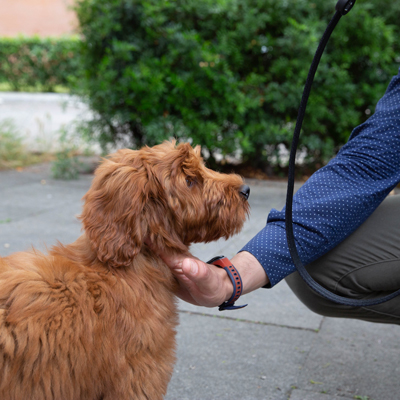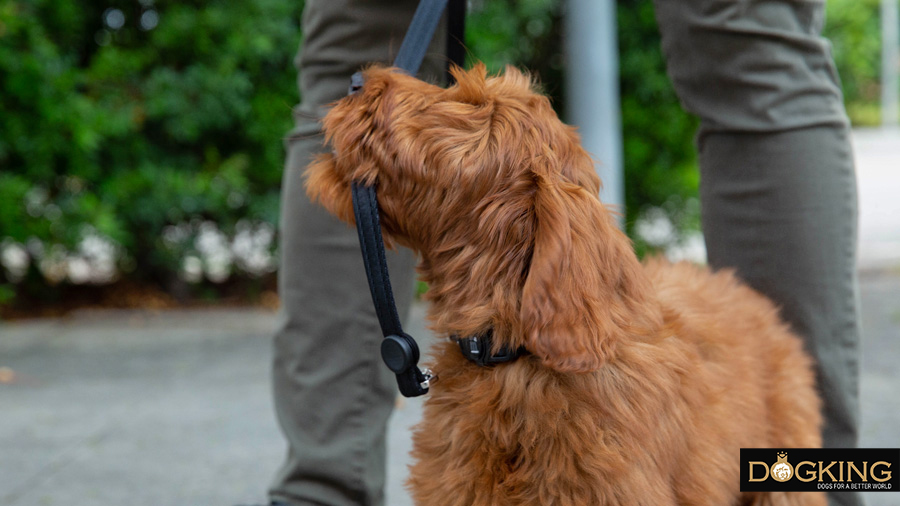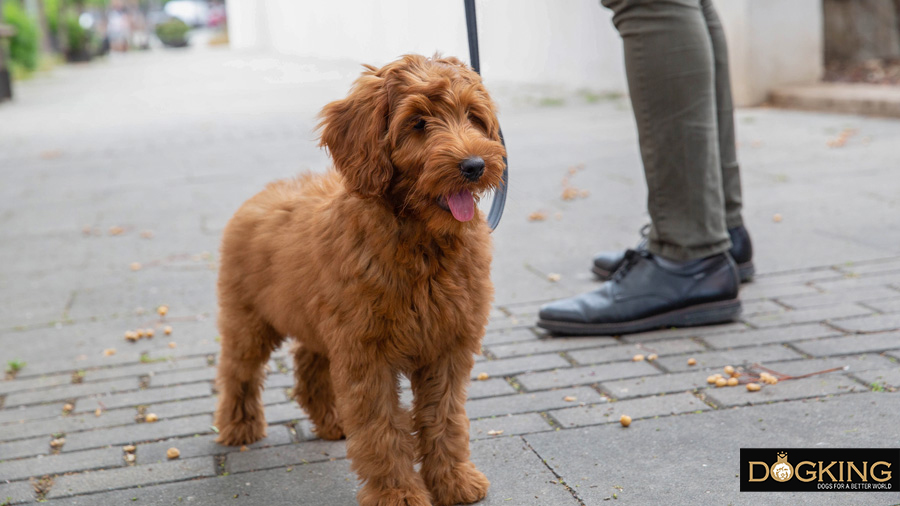What should I do to stop my dog from chewing on the leash
We show you how to put an end to this uncomfortable behaviour of your pet

WHAT HAPPENS IF MY DOG CHEWS ON THE LEASH?
Reading time about 9 minutes
We know how frustrating it may be to go for a walk with your dog and the animal keeps chewing on the leash and trying to play with the leash. This habit of your pet is very annoying, as it turns the walk into a constant struggle and involves risks such as the leash breaking and the animal running away, hurting its mouth, or swallowing a piece of cloth. Normally, this behaviour usually starts in puppyhood as a game, but it is important to correct it as soon as possible to prevent it from becoming a habit for the adult dog.

Table of contents
1- Why does my dog chew on the leash when we walk?
2- How can I prevent my dog from chewing on the leash?
3- Which materials are more advisable?
Why does my dog chew on the leash when we walk?
- Lack of stimulation: If your dog feels bored or unmotivated during walks, it may chew on the leash to entertain itself. Try to take the animal to different places and bring along some of its favourite toys to make the walks really enriching for your pet.
- Toothache: In both puppies and adult dogs, chewing on the leash may be due to pain in the teeth, although in this case you will notice that your pet chews on other things as well.
- Nervousness: If your dog feels stressed on a walk, either because of too intense external stimuli or because it hasn't been properly socialized, it is likely to show its anxiety by chewing on its leash. It is important to get dogs used to all kinds of walks from a young age, gradually increasing the variety and intensity of the stimuli.
- Discomfort: Your dog may be asking for freedom by chewing on the leash. In the city it is usually compulsory to keep dogs on a leash, but make sure you regularly take it to the countryside or to places where the animal is allowed to walk off leash. This will allow your dog to run free and it will feel much happier and more fulfilled.
- Habit: If the behaviour started as a puppy and the animal wasn't corrected or even worse it has received a positive reinforcement (with affectionate words, strokes or even scolding), it is logical that as an adult dog will continue to chew on the leash. This habit may also occur if you usually play tug of war with your pet. In these cases, the animal doesn’t know that the leash isn’t for playing, so your dog must be corrected and taught.

How can I prevent my dog from chewing on the leash?
For whatever reason, if your dog constantly chews on its leash and turns walks into a series of tugging and pushing movements and, ultimately, a stressful time for both of you, don't worry about it. Reversing this behaviour is possible, although it requires a lot of patience if your dog is already an adult.The ideal is to start this training while the animal is still a puppy. Here are some guidelines to get your dog to stop chewing on the leash.
Teach your dog to walk on the leash
If your dog is a puppy, teach it early on to accept the leash and carry it calmly and naturally. Before going outside, start practicing at home by having your pet examine and sniff the leash. Then, put the leash on the animal for a short time while you reward it with some treats or strokes, but don't move, let the leash just rest on the floor. With this exercise you will get your dog to begin to associate the leash with something positive.
After repeating this several times, try picking up the leash and walking with your puppy around the house. If it walks calmly by your side, reward your dog with a treat, but if it walks away, stop and call your dog back. When the animal comes to you, reward your dog again with treats or strokes. Little by little, you can introduce in your path some distracting elements, such as toys or other people. This way you will measure your dog's capacity of concentration and, little by little, the animal will advance in this learning process. When it is time to go out in the street, once the puppy has all the necessary vaccinations, start with quiet places without too many stimuli.
Distract your dog's attention
This advice applies regardless of the dog's age. If during the walk, your pet starts trying to play with or chew on the leash, stand up and ask the dog to drop it if you have trained this signal. You can encourage your dog by offering it one of its toys, which will distract its attention and make the animal let go of the leash. When your pet starts playing with it, reward it so that your dog understands that this object is fun and pleasant to play with.
Create a play routine
If your dog sees the leash as a toy, try scheduling one playtime a day at the same time every day. Establishing a schedule may help your dog understand that this, and no other, is the time to have fun playing. If that playtime is just before the walk, your dog will probably already be quite stimulated and enjoy the outing in a calmer and more focused way. In this way, your dog is less to feel the urge to play around with the leash.
Correct its behaviour
If you want your dog to let go of the leash, don't scold it, as your pet may interpret this as a reinforcement. After all, when we get angry with our pet, we are giving it our attention that the animal may misinterpret. The best thing to do in this case is to stop the walk completely and even turn your back on the animal, ignoring it for a few moments. If the dog lets go of the leash, we will restart the walk, but if your pet continues chewing on the leash, we will repeat the exercise to show the animal that when it shows this behaviour, the fun of the walk and our attentions stop.
Another idea is that you play to shorten or loosen the leash depending on the dog's attitude. When your pet chews on the leash, pick it up by wrapping it around your hand to tighten it and bring the dog closer to your side. Stop walking and stay that way for a few moments. If your pet stops chewing, you may loosen the leash to reinforce the behaviour.
Don’t pull on the leash
When your dog chews on the leash during a walk, try not to tug or twist the rope. This tugging may be a lot of fun for your dog, so you will be reinforcing its behaviour and the animal's idea of play about the leash. Besides, even if the pull isn’t very strong, you may hurt the animal unintentionally. The best thing to do is to try some of the exercises we have mentioned before and forget about pulling the leash or scolding your dog.
Consultation with an Ethologist or a Trainer
Although it is most common for your dog to chew on its leash to play, there are other more serious causes that could explain this behaviour. This seemingly harmless mania could hide a behavioural disorder, such as canine anxiety or a problem with teeth or a lack of nutrients. It isn’t the most common, but it never hurts to be on the safe side and prevent any problem by visiting your vet for a routine check-up. In cases where the dog shows excessive fixation on the leash and doesn’t react to positive reinforcement, we recommend professional advice from an ethologist or a trainer.
Which materials are more advisable?
While you are teaching your dog to stop chewing on the leash, we recommend that you use a leash that is as stong as possible. Nylon or leather are the most suitable materials in case your pet does or doesn't chew on the leash. These types of fabrics are of high quality and very strong, so it will be very difficult that the dog’s leash may be broken.
Training our dog to walk on the leash correctly is esential for the animal to enjoy all its benefits. Through walks, dogs explore the environment, socialize with other dogs and people, and are cognitively stimulated. If your pet doesn’t stop chewing on its leash excessively, the animal won’t be able to fully benefit from this necessary and positive routine. Remember to redirect this behaviour as soon as you detect it so that you can continue to enjoy pleasant walks with your furry friend.